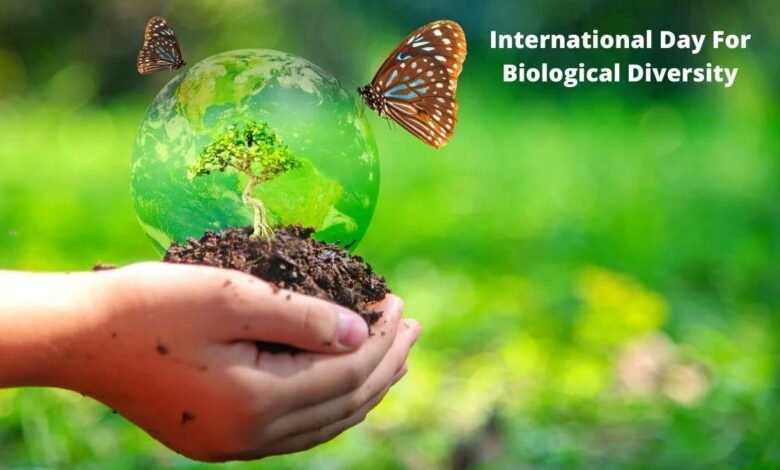International Day for Biological Diversity: Protect Biodiversity Today for a Sustainable Future

Life depends on small, interconnected moments, like a bee pollinating a flower, a bird building a nest from twigs, or a fungus helping a tree breathe.
Every year on May 22, we are reminded of something profound yet often overlooked: despite growing cities and advancing technologies, the soil beneath our feet and the distant forests still support all life.
The International Day for Biological Diversity is more than a date on the calendar; it is a wake-up call. It urges us to preserve the rich web of life on Earth before it unravels, and to do so not only for ourselves but for our children, who will inherit what we choose to protect or neglect.
Origin of the International Day for Biological Diversity
Each year on May 22, we observe the International Day for Biological Diversity, also known as World Biodiversity Day. The United Nations established this day to raise global awareness about biodiversity-related issues.
The observance aligns with the UN Sustainable Development Goals (SDGs), which address food security, energy, health, climate change, clean water, sanitation, and sustainable agriculture. The document “The World We Want: A Future for All”, released during the Rio+20 Summit, emphasized biodiversity as a foundation of sustainable development.
Initially, the UN General Assembly’s Second Committee created this observance in 1993. It was first held on December 29, marking the date the Convention on Biological Diversity came into force. In 2000, the date was shifted to May 22 to commemorate the Convention’s adoption during the Rio Earth Summit in 1992. The change also avoided the overlap with end-of-year holidays.
International Day for Biological Diversity 2025 Theme
The 2025 theme, “Harmony with Nature and Sustainable Development,” emphasizes the inseparable relationship between biodiversity and the SDGs. It is a call to pursue progress in a way that respects ecological limits.
This theme also reflects urgency. By 2025, only five years remain to achieve the 2030 biodiversity and development goals set in the Global Biodiversity Framework.
The focus is on coexistence, not dominance. As we rush toward innovation and expansion, we should pause and ask: What are we leaving behind for our children and future generations?
Why the International Day for Biological Diversity Matters
This day is vital in today’s world. It offers a global platform to educate people and raise awareness about the importance of biodiversity for the planet and for us, whose futures depend on a healthy environment.
It highlights the value of different species, ecosystems, and genetic resources. It also demonstrates how biodiversity is intricately linked to achieving the SDGs.
On this day, communities showcase how protecting nature contributes to clean water, stable food supplies, climate resilience, and better health outcomes.
What Does Biological Diversity Mean?
Biological diversity or biodiversity includes the full variety of life on Earth: animals, plants, microbes, and entire ecosystems. This includes deserts, grasslands, lakes, coral reefs, forests, and even green spaces in cities.
Biodiversity also involves genetic variation, such as the thousands of livestock breeds and rice varieties globally.
Every part plays a role: forests purify the air, wetlands filter water, bees pollinate crops, and microorganisms enrich soil. These processes support life on Earth and are essential for a livable world, for adults and children alike.
Biological Diversity Supports Life
Many of us underestimate the importance of biodiversity in our everyday lives. Nature is not a luxury, it is the foundation of our existence. Plants make up over 80% of the human diet. Fish are the primary source of protein for around 3 billion people. About 80% of rural populations in developing countries rely on plant-based traditional medicine for their healthcare.
Biodiversity also influences weather patterns, disease regulation, and mental well-being. Everyone, including children, benefits from spending time in biodiverse environments like gardens, which reduces stress and improves cognitive development.
The Damage We Have Caused
Despite its importance, biodiversity is in crisis. Three-quarters of land environments and two-thirds of marine habitats have been significantly altered by human activity. Currently, one million plant and animal species are at risk of extinction.
This alarming trend is driven by deforestation, pollution, overfishing, habitat loss, and climate change. Many species are vanishing before they are even discovered. Each extinction means a loss of potential medicines, food sources, and ecosystem services. This isn’t just an environmental issue, it’s about the survival of all people.
Protecting Biological Diversity
In December 2022, the world’s nations adopted the Kunming-Montreal Global Biodiversity Framework, which outlines 23 targets for 2030 and 5 broader goals for 2050. These include restoring 20% of degraded ecosystems and halving the spread of invasive species.
The framework links biodiversity directly with the SDGs, emphasizing that efforts to fight poverty, ensure clean water, and combat climate change depend on thriving ecosystems. A future for our children depends on this alignment.
There Is Not Much Time Left
The urgency is real. With less than five years remaining, we risk missing the 2030 targets. Delays could push ecosystems past irreversible tipping points. Species go extinct. Forests take decades to regrow. Oceans need years, if not centuries, to recover.
Addressing this crisis requires education, innovation, and collaboration. Governments should increase funding for conservation.
Businesses should reduce waste and rethink how they source materials. Communities should protect local biodiversity, and individuals, rethink consumption habits. Parents should also teach their children to embrace daily lifestyle habits that do not harm the ecosystem.
The Ripple Effect of Biodiversity Loss
Biodiversity loss triggers a chain reaction. When insects disappear, pollination fails. Crops collapse. Food security becomes unstable. The system is delicate: if one link fails, others follow.
This affects everything from disease outbreaks and animal migration to climate stability and the global economy. As habitats shrink, wildlife moves closer to human populations, raising the risk of zoonotic diseases like COVID-19. Preserving biodiversity isn’t just about protecting nature, it’s a form of public health and safety.
Celebrate With a Reason
The International Day for Biological Diversity is more than symbolic. It’s a time to act, learn, and share. The UN’s Learning for Nature portal offers free biodiversity courses on conservation storytelling, sustainable businesses, and using science to guide policy.
Children can join biodiversity-themed workshops, school activities, and nature walks. Social media campaigns, art challenges, and community cleanups are excellent ways to participate. Every story shared today can inspire change tomorrow.
Raising Awareness of Biodiversity
Living in harmony with nature means respecting boundaries, not conquering ecosystems but understanding them. This principle is central to many indigenous cultures, whose traditional knowledge is vital for modern conservation.
Even urban areas can support biodiversity through restored wetlands, rooftop gardens, and tree-lined streets. Children in cities can learn that nature isn’t something “out there”, it’s right here.
Schools can foster a love for biodiversity through books, games, outdoor lessons, and science projects. Building respect for nature from an early age lays the foundation for future guardians of the planet.
Conclusion
We are at a turning point. One path leads to continued loss and instability. The other offers health, peace, and resilience. The choice is ours.
This International Day for Biological Diversity, remember: the planet doesn’t need saving from us, it needs saving with us. By protecting biodiversity, we protect communities, ourselves, and our children.





